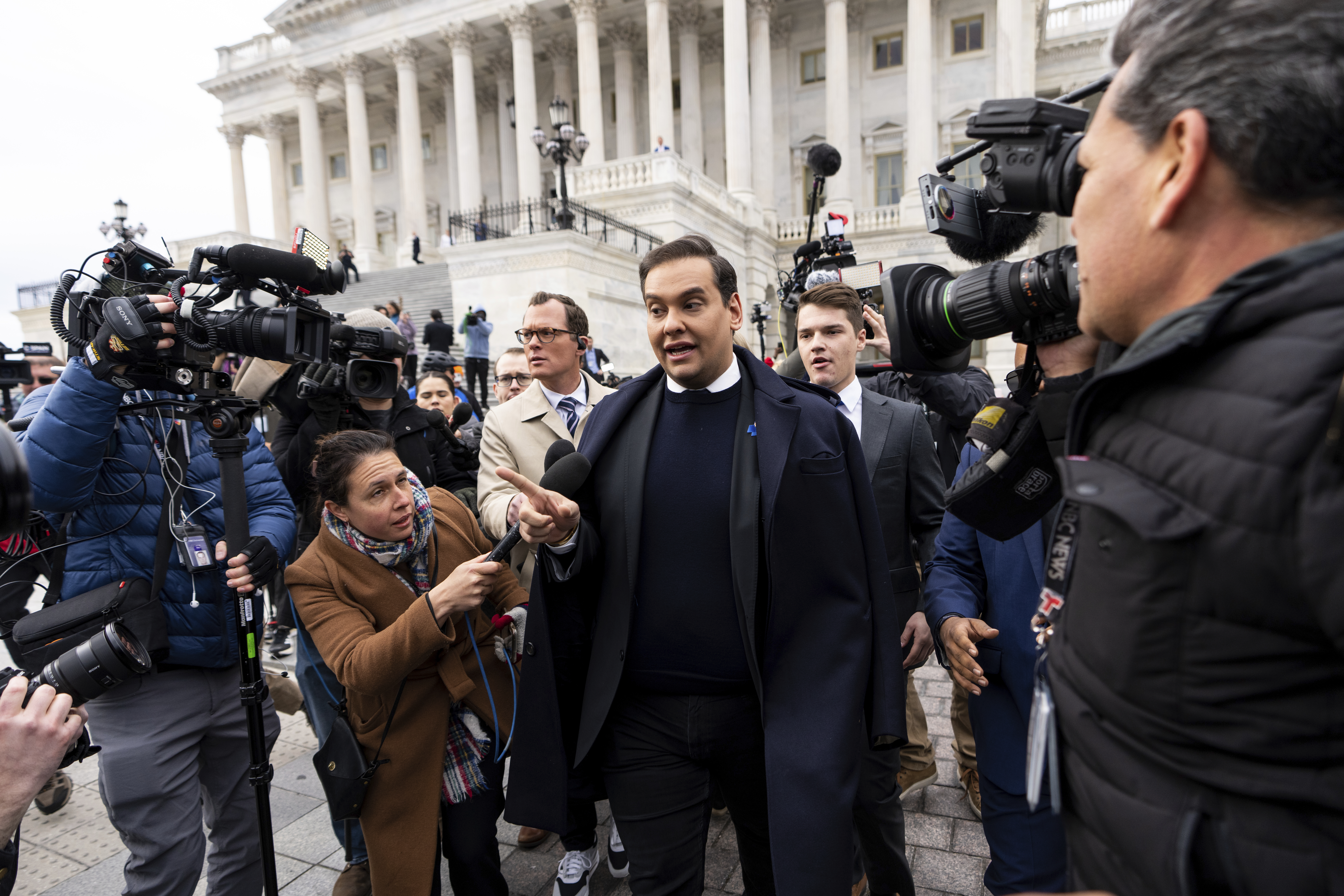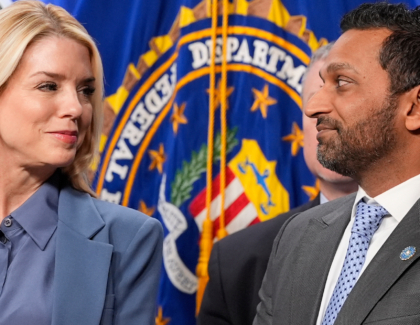Sign up for the daily CJR newsletter.
On Friday, the trail of lies and fraud allegations in the wake of George Santos, the New York congressman, appeared finally to catch up with him as his colleagues in the House voted to expel him. Before the vote was done, Santos stalked out of the building, held off a scrum of journalists, and jumped in a waiting car. “To hell with this place,” he told a reporter from CNN, adding that, as he was no longer in Congress, “I no longer have to answer your questions.”
The story of Santos and the media began with questions the press didn’t ask—or rather did, but didn’t amplify until it was too late. Last year, when Santos was running in a tight race on Long Island, the North Shore Leader, a local paper, raised a red flag around his financial disclosures and résumé—suggesting that he was likely “a fabulist” and “a fake”—but the story didn’t blow up nationally until December, when the New York Times reported on a series of eye-popping (and false) claims about his biography. By that point, Santos had already won election, leading to a round of agonized hand-wringing about the broken local-to-regional-to-national news pipeline and its failure to check his ascent. (Over the weekend, this argument came back around, including in an op-ed that Grant Lally, the Leader’s publisher, wrote for the Daily Beast.)
Once the national press started asking questions about Santos, the media story shifted to his refusal to answer them. He ignored initial inquiries from journalists (including mine, as I reported on his claims about a supposed past media career); Hakeem Jeffries, the incoming House minority leader, quipped that Santos may as well have been in the “witness protection program.” As Santos entered Congress, a viral video showed him striding down a corridor, his gaze fixed straight ahead, stonewalling journalists’ repeated questions. Reporters would remain camped outside his office for weeks, chasing him through the Capitol whenever he emerged. Still, Santos wouldn’t give them answers. “You guys keep asking me the same questions, and it pains me. You guys don’t go to eat. You guys don’t take a break. And it frustrates me that you’re sitting there outside of my door all day,” he said at one point. “I will address you guys on my time.”
Even at this point, though, he was teasing the press, too. When he finally broke his silence on the Times’ reporting, it was to promise that he’d talk the following week; one day, he trailed a surprise for the “journalists” (scare quotes his) staking out his office. (It was donuts and coffee.) He also offered them some verbal treats (his favorite song of the moment? “Unholy,” by Sam Smith and Kim Petras); one congressional correspondent told Vanity Fair’s Joe Pompeo that they suspected Santos was deliberately courting the scrum, or at least not going out of his way to avoid it. (“He’s an idiot,” the correspondent said, “but he’s not an idiot.”) As time passed, suggestions that Santos was loving all the attention, actually, swelled. He did right-wing media hits and sat down with Piers Morgan. The internet blew up after he walked out of a colleague’s office carrying a mysterious baby. (Was it his? reporters wanted to know. “Not yet,” Santos said.) As summer turned to fall, he started calling one of the Times reporters who blew his story wide open, having vowed never to speak to her. They talked about the case against him (by this point, he had been indicted on fraud charges), and also about pets and baby showers.
Shortly before Thanksgiving, the House Ethics Committee dropped a scathing report about Santos, accusing him—among many, many other things—of using campaign funds to buy meals, Botox, and purchases from OnlyFans, a platform popular with explicit-content creators. His expulsion came to look inevitable. As the vote approached, the Santos media story entered a stage we might call gleefully answering questions no one asked. He organized a press conference and promised “big news,” but didn’t say much of consequence. Over the weekend, the presser got the Saturday Night Live treatment. “I’m sure you bloodthirsty jackals in the media have a thousand mean, nasty questions you’re dying to ask,” Bowen Yang, playing Santos, said. “You called this press conference,” a cast member playing a reporter replied.
Already, there is rampant speculation about Santos’s next act, which may be a media story in the most literal sense. “I realized I’m highly employable,” he said last week. “They’re offering me jobs left and right, from media to entertainment to public advocacy.” He mused about writing a book, and said he would consider a spin on Dancing with the Stars. Over the weekend, he apparently agreed to a pay-per-view interview with Ziwe, a popular comedian and talk show host. And we learned that a Santos movie is already in the works, optioned by HBO Films and helmed by Frank Rich, the journalist who also executive-produced Veep and Succession. Per Deadline, the movie will focus on Santos’s campaign, and will be “forensic and darkly comic.”
“Forensic and darkly comic” could also describe the media coverage of Santos and its trajectory over time. Since his story belatedly blew up a year ago, we’ve seen some stellar investigative reporting on him. Also, and increasingly, he has become a meme, in the online and broader cultural senses of the word. Coverage of his ouster variously referred to him as a “figure of national ridicule” and “the nation’s punchline.” “Who doesn’t love to talk about George Santos?” the Washington Post asked last week. “This is the paradox of Santos’s downfall. His falsehoods and alleged crimes have been bold enough to be galling, yet frivolous enough to be funny.”
I enjoy a good meme as much as the next millennial. And, as I’ve written repeatedly in this newsletter, there’s no necessary contradiction in finding a given news story serious and funny at the same time—indeed, humor and ridicule can provide their own mode of scrutiny and accountability. (See: Bowen Yang.) At root, though, Santos’s misdeeds—confirmed and alleged—are serious, and I can’t avoid the conclusion that this has gotten lost in at least some of his memeification. (Yes, yes, I know this makes me a grouch.) Santos, for his part, seems to have progressively leaned into this memeification, embracing the great modern media lesson that you can’t be the punch line—at least, not entirely—if you’re in on the joke.
Santos’s next act, of course, may very well be prison. And it’s possible that our fickle attention economy, having picked Santos up, will just as quickly put him down. But he has already exploited multiple pathologies of that attention economy, rising to Congress thanks in no small part to a deficit of timely attention, then riding the surfeit of it to celebrity; if you think he can’t leverage this into long-term relevance—who knows, maybe even a political comeback—I have some precedents to show you. If he does, it will be a feat inextricable from his current status as a media object. Selling himself as one might just be his greatest grift, perpetuated in plain sight.
I am, admittedly, using the term “media” loosely here. The news media are by no means entirely responsible for this state of affairs; memesmiths and moviemakers don’t number among our ranks. (Well, don’t always.) Fundamentally, though, Santos attracts all of us for the same reason: he’s a great character. In the press, these can be a good thing; journalists are taught to find them, to help us humanize and narrate complex stories in compelling ways. But they are also essential to journalism as a commercial product, as entertainment. (“I find it incredibly unique and incredibly fun to cover,” one reporter told Pompeo earlier this year. “It’s comical, some of the stuff he has done. I mean some of it could also be dangerous, but it’s just a great story.”) Our use of Santos as a character fits the latter mold better than the former. When you consider that his scandal hinges on him inhabiting roles he never played, it’s close to unforgivable.
Our elevation of Santos as a character has had another bad side effect: at least implicitly, it has made of him an exceptional figure. (Headlines centering the rare bipartisanship of the expulsion vote only reinforced this idea.) In some ways—his brazenness, and the sheer extent of his lies—Santos is exceptional. But politicians lying about their backgrounds is common, as is politicians, well, just lying. On his way out the door, Santos himself has not been shy about making this point; as The Nation’s Chris Lehmann put it, he has (quite effectively) pointed out “the ludicrous nature of identifying and enforcing a code of ethics in a government operating on the basis of open graft.” Just as Santos entered Congress, 139 of his Republican colleagues in the House voted to overturn the 2020 election—another brazen fraud on the American people. The vast majority have escaped having media characters made of them, for better or worse.
Some of the voluminous coverage of Santos has situated him as a creature of Donald Trump’s Republican Party. Mostly, though, he has free-ridden on the miserable incentives—including lavish media attention—that come with this status. Santos’s behavior, like Trump’s, has deserved significant critical scrutiny, but at some point, like with Trump, we collectively jumped the shark and the attention became the point. The irony here is that if the attention had come earlier, we may have been spared the character of Congressman Santos at all. Not that that lesson will be learned. In his Daily Beast essay, Lally, of the North Shore Leader, claimed that his paper has since reported on other candidate scandals on Long Island that haven’t gotten any national-media follow-up. “Sadly,” Lally wrote, “little has changed.”
Other notable stories:
- On Friday, following a pause, fighting resumed between Israel and Hamas. According to the Committee to Protect Journalists, three media workers—Abdullah Darwish, a cameraman with a Hamas-affiliated TV station; Montaser Al-Sawaf, a cameraman for the Turkish state news agency Anadolu; and Adham Hassouna, a freelance journalist and media professor—were killed in Israeli air strikes the same day, bringing the confirmed death toll among media workers in the conflict to sixty-one. In an essay for the New York Times, Lama Al-Arian highlighted this toll and remembered her friend Issam Abdallah, a journalist for Reuters who was among those killed. Meanwhile, in the US, police in Tucson, Arizona, arrested Alisa Reznick, a reporter with the public-radio station KJZZ, while she was covering a pro-Palestinian protest, and charged her with trespassing.
- Cooper Inveen reports, for Canada’s Globe and Mail, on the death last week of Stephen Douglas, a Canadian journalist in Sierra Leone. Douglas was found dead after leaving his home to cover the aftermath of fighting in Freetown, the capital; local authorities said that he died of a heart attack, but that account “has been met with skepticism among Sierra Leone’s journalists,” Inveen writes. In other international press-freedom news, the military rulers of Burkina Faso blocked circulation of Le Monde, citing a story that the paper published about a jihadist attack on a military base in the country. And authorities in Azerbaijan detained Nargiz Absalamova, a journalist with Abzas Media—part of a wider crackdown on an outlet that, per CPJ, is known for “bold anticorruption coverage.”
- In the US, the office of Pamela Price, the district attorney in Alameda County, in California’s Bay Area, barred Emilie Raguso—a journalist who runs the Berkeley Scanner, a news site that covers public safety—from a press conference last week, citing “safety issues” without defining them. (Other members of the media were permitted to attend.) Over the weekend, after press-freedom groups raised concerns about Raguso’s exclusion, Price’s office told Raguso that she would be welcome at future events and that she would begin to receive media releases. (She was removed from the office’s media list earlier this year.) Alex N. Gecan has more for Berkeleyside.
- Writing for De Los, a section of the LA Times, Jack Herrera grappled with the twin questions of his objectivity as a journalist, in general terms, and as a Mexican American journalist, in particular, following Univision’s controversial recent interview with Trump. “Does being a Mexican American mean subscribing to certain politics? As a Latino, are there certain positions that are opprobrium with my heritage?” Herrera asks. “I can only answer that first question about journalist objectivity, precisely because the decisions I’ve made as a reporter mean that, officially, I have no opinion on the second question.”
- And Maria Martin, who created the public-radio show Latino USA, has died. She was seventy-two. “For nearly half a century, Martin brought the voices of Latin Americans and Latinos in this country to public radio. She reported on politics, violence and resilience of indigenous communities in Central America. Most recently, she filed reports from Guatemala,” NPR reports. Martin once said that her vision for Latino USA was to “reflect the diversity of the Latino community in all of its beauty, and in all of its pain.”
ICYMI: O Talentoso Senhor Santos
Has America ever needed a media defender more than now? Help us by joining CJR today.







